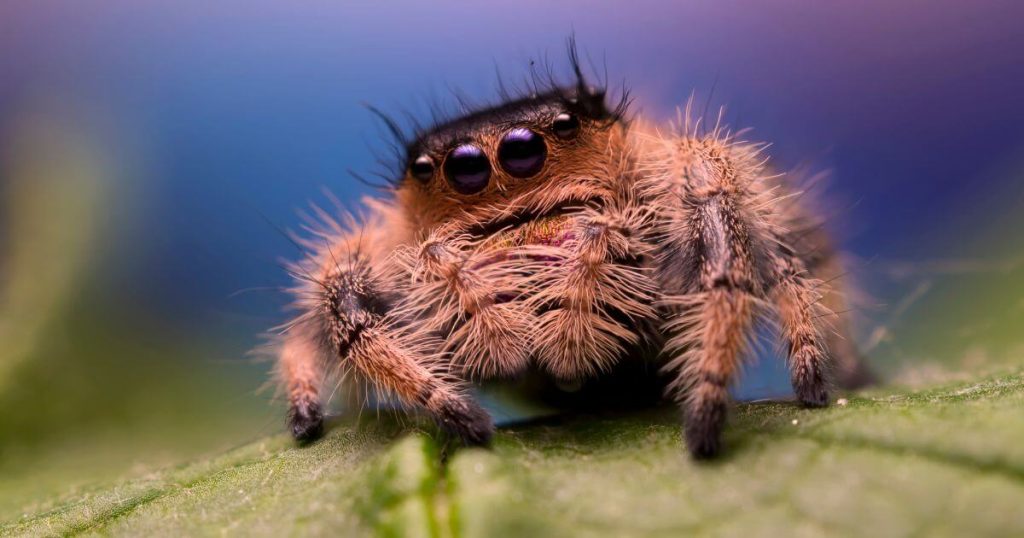
Is the Jumping Spider a Good Pet?
Welcome to the fascinating journey into the world of these eight-legged creatures, where understanding their unique traits and needs is paramount. When selecting a species, it’s essential to consider various factors such as their temperament, size, and environmental requirements. Different species exhibit diverse behaviors; some might be more active and visible, while others could be shy and reclusive.
Different Personality Traits of Jumping Spiders
The personality of jumping spiders can vary significantly among different species, adding to their appeal. For instance, the Phidippus regius is often bold and curious, frequently seen exploring its enclosure and engaging with its environment, sometimes even showing interest in human activities. On the other hand, species like Maratus volans, known for their remarkable courtship dances, might be shyer, spending more time concealed within their web or shelters. Such behavioral differences reflect the diversity within the jumping spider family, making each species unique in its way and influencing how they interact with their surroundings and caregivers.
Crafting Ideal Habitat for Pet Spider
Environmental needs are crucial for the well-being of jumping spiders. Different species have varied preferences. Some thrive in humid conditions, requiring regular misting to maintain moisture. Others need a drier environment, which can be achieved with proper ventilation and less frequent misting. The right temperature range is equally important, often reflecting the climate of their natural habitat. Lighting, too, plays a significant role. While some spiders are fine with ambient room light, others might benefit from a more controlled lighting setup, mimicking natural light cycles. Understanding and replicating these conditions in their enclosure is key to creating an ideal habitat that caters to their specific needs, ensuring their health and happiness.
What is the Lifespan of Spiders
The lifespan of your pet jumping spider is a critical factor to consider before bringing one into your home. Different species of jumping spiders have varying lifespans. Some species can live for several years, which means you’ll be committing to a long-term care relationship. On the other hand, other species have shorter lifespans, which might be more suitable for those looking for a shorter-term commitment. Understanding the expected lifespan of the species you choose helps in preparing both emotionally and in terms of care for the entire duration of your spider’s life.
Choosing a spider species based on comfort and experience
When choosing a jumping spider species, consider your experience level. For beginners, Phidippus regius (Regal Jumping Spider) or Phidippus audax (Bold Jumping Spider) are great choices due to their resilience and simpler care needs. More experienced owners might opt for species like Hyllus diardi, which require more specialized care and attention. It’s important to select a species that matches your ability to provide proper care, ensuring a positive experience for both you and the spider.
The Reward of Spider Care
Embarking on the journey of understanding and caring for a jumping spider is deeply rewarding, offering insights into the fascinating world of these creatures. This process, starting with selecting a species that aligns with your preferences and capabilities, involves a continuous learning curve. By observing and adapting to their unique needs and behaviors, you not only ensure their well-being but also develop a deeper appreciation for their individuality. Each interaction with your spider can reveal more about their complex and often misunderstood nature, making it a fulfilling experience.
Creating a Cozy Corner for Your Jumping Spider
Embarking on the journey of setting up an ideal habitat for your jumping spider is both creative and critical. This process involves more than just aesthetics; it’s about replicating their natural environment to ensure their well-being. Key considerations like space, temperature, and safety are vital in crafting the perfect habitat.
Ideal Temperature and Humidity for Jumping Spiders
Jumping spiders are highly sensitive to their environment, requiring precise temperature and humidity control. For popular pet species like Phidippus regius and Phidippus audax, moderate temperatures around 70-85°F (21-29°C) are ideal. Humidity levels should be maintained at 50-70% for optimal health. Investing in a reliable thermometer and hygrometer is essential to closely monitor and adjust these environmental factors, ensuring the habitat remains consistent and comfortable for your spider. This attention to detail in climate control is crucial for their well-being.
Building a Stimulating Environment
Creating an inviting and stimulating enclosure for your jumping spider is key to their well-being. It involves more than just placing random sticks and leaves; it requires thoughtful design to mimic their natural habitat. Incorporating elements like climbing walls, a variety of plants, and comfortable hiding spots creates a landscape that not only looks great but also encourages your spider to engage in natural behaviors. This setup provides mental stimulation and helps your spider stay active and healthy, enjoying an environment that closely resembles their wild habitat.
The Right Light for Jumping Spiders
Appropriate lighting in a jumping spider’s enclosure is vital. It’s not just about illuminating their space, but about replicating the natural light cycle they would experience in the wild. This aspect of their environment can greatly influence their health and behavior. Depending on the species, some spiders may thrive under brighter conditions, while others prefer more subdued lighting. Striking the right balance based on the specific needs of your spider’s species is essential for creating an environment that promotes their well-being and mimics their natural habitat.
How to Keep Jumping Spiders Safe
Ensuring the safety of your jumping spider is crucial. Their natural curiosity may drive them to explore, potentially leading to escape attempts. To prevent this, it’s important to ensure their enclosure is secure and escape-proof. Regular checks and maintenance of the enclosure are vital to identify and fix any potential weak spots or openings. This ongoing vigilance helps keep your spider safely contained within their environment, preventing them from embarking on unplanned explorations outside their designated space.
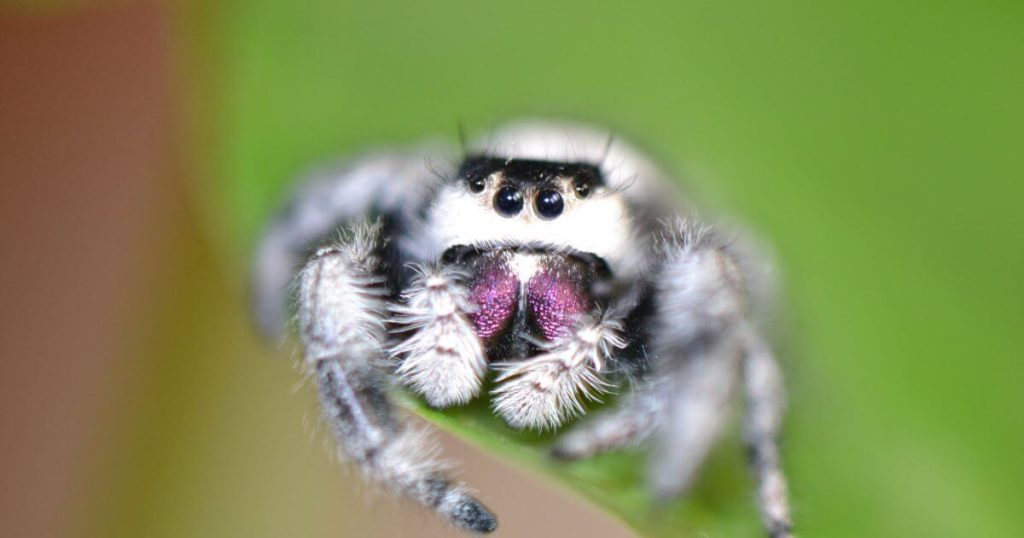

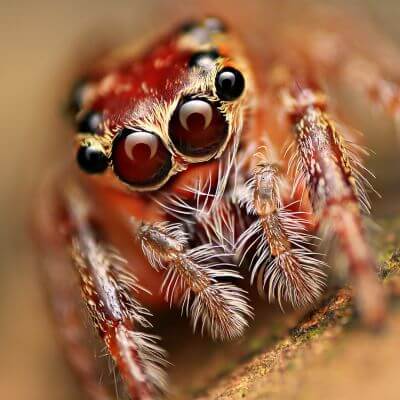
Understanding Spider Diets
Jumping spiders primarily feast on live insects, with preferences varying by species. Common choices include flies, crickets, and small moths. It’s crucial to offer prey that’s appropriately sized – typically, no larger than the spider’s body.
How Often and How Much to Feed Jumping Spider
Feeding adult jumping spiders 2-3 times a week is typically adequate. However, the frequency can vary based on the species and the individual spider’s activity level. For instance, a highly active Phidippus audax may require more frequent feedings compared to a less active species. Juvenile spiders, still in their growth phase, generally need more frequent meals, possibly daily or every other day, to support their rapid development. Overfeeding can lead to health issues, so it’s important to watch for signs of adequate nutrition, such as a well-rounded abdomen, and adjust the feeding schedule accordingly. Regular observation and adjustments ensure the spider receives the right amount of nutrition without the risk of overfeeding.
Varied Diet and Supplements
Providing a variety in the diet of jumping spiders is crucial for their overall health and development. Feeding them different types of insects ensures they receive a wide range of essential nutrients. For instance, alternating between fruit flies, small crickets, and occasional mealworms can be beneficial. Additionally, dusting the prey with calcium or vitamin supplements is particularly important for certain life stages or conditions, such as breeding females or rapidly growing juveniles. These supplements help in preventing nutritional deficiencies and supporting overall health, contributing to their well-being and longevity.
Feeding Techniques to Engage Jumping Spiders
Feeding your jumping spider can be a highly interactive and engaging process. Utilizing feeding tongs to offer prey not only adds an element of interaction between you and your spider but also stimulates the spider’s natural hunting instincts. This approach can be particularly enriching for the spider, encouraging active behavior. However, it’s important to remove any uneaten prey after a while to maintain the cleanliness of the enclosure and prevent potential stress for the spider. Regular removal of leftovers helps in creating a healthy and stress-free environment for your pet.
Hydration: The Overlooked Essential
While jumping spiders require minimal water, ensuring adequate hydration is key. A shallow water source, such as a small, shallow dish or a damp sponge, can provide sufficient water without posing drowning risks. Regular misting of the enclosure is another effective way to aid hydration, especially for species that prefer more humid environments. The amount of water provided should be just enough to keep the environment slightly humid without making it overly wet, as too much moisture can lead to mold growth or other health issues for the spider.
Health and Wellbeing of Jumping Spiders
Ensuring your jumping spider is healthy is like being a spider detective! It’s about noticing the little things in their behavior and appearance. Is your spider energetically hunting and exploring? That’s great! But if they’re moving slowly or look too skinny, it’s time for some sleuthing. These subtle cues can be clues to their health – a bit like solving a mystery to ensure they stay happy and sprightly. Keeping an eye on these details is key to their well-being.
Keep an Eye for Small Changes in Spider
In the fascinating world of spider care, the little changes can mean a lot. If your jumping spider isn’t climbing as much as usual, or if you notice a change in their color, it might be time to take a closer look. These signs can be subtle indicators of health issues. For instance, a change in color could signify nutritional deficiencies or stress. Reduced activity might mean your spider isn’t feeling well. It’s all about being observant and catching these small yet significant signs early.
Molting: The Spider Glow-Up
When your jumping spider molts, it’s like they’re taking a mini-break to refresh their wardrobe. They might lay low, not eat much, and just chill for a bit. This downtime is crucial as they shed their old exoskeleton and grow a new one. It’s important to ensure their enclosure has the right humidity during this process. Proper humidity levels help them shed smoothly, preventing any issues that might come from a molt gone wrong. So, keep the environment just right for their big change!
A Clean Home is a Happy Spider Home
Regular cleaning of your jumping spider’s enclosure is crucial for their health and happiness. Think of it as providing them with luxury accommodation. A clean habitat prevents pests and germs, which can be harmful to your spider’s health. It’s not just about removing old food or waste; it’s about maintaining an environment that’s comfortable and safe for your spider to thrive in. A well-maintained enclosure is key to ensuring your spider’s home is always a cozy and healthy place for them to live.
When to Call in the Spider Experts
If your jumping spider is not acting like its usual self, it’s wise to seek advice from an expert. Changes in behavior or health that persist might require professional insight. Consulting an arachnid specialist or a vet experienced with spiders can provide peace of mind and ensure proper care. Remember, a happy spider reflects good care. By staying vigilant and providing the right environment and attention, you’re setting the stage for a healthy, entertaining pet spider experience.
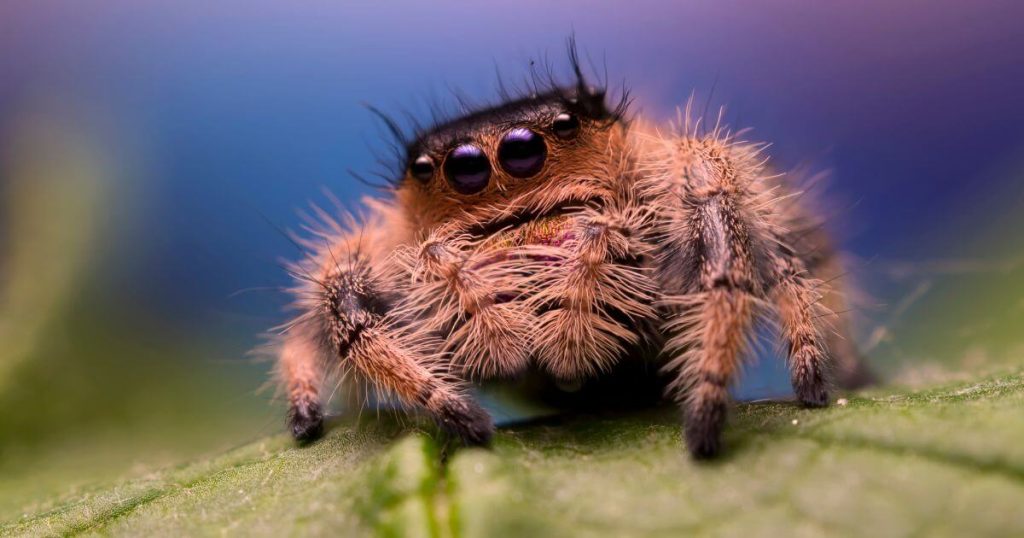


Jumping Spider Personalities and Behaviors
Spiders Are Agile Acrobats
Jumping spiders truly embody the spirit of tiny, energetic acrobats. Their behavior often appears curious and playful, making them a delight to observe, much like a live-action nature documentary in miniature. These spiders are known for their unique hunting tactics, which involve carefully stalking their prey and then executing precise, agile leaps to capture them. This fascinating hunting behavior showcases their agility and precision, making them not only captivating pets but also a window into the intricate world of arachnid behavior.
Spiders are Social
Jumping spiders aren’t just about hunting; they have a rich social life, especially evident in their mating rituals. Some species showcase complex and colorful dances, where males perform elaborate moves to attract females. These displays are not only about procreation but also a fascinating glimpse into spider communication and social interaction. This aspect of their behavior is like witnessing a lively, colorful dance party in the world of spiders, adding another layer of intrigue to these captivating creatures.
Jumping Spiders “Staring Eyes”
Jumping spiders are known for their “staring” habit, a result of their exceptional vision. They use this acute eyesight to observe their surroundings and even watch their human caretakers with apparent curiosity. This behavior is part of what makes them so engaging as pets – they seem to take an interest in your activities, adding to the unique interaction you can have with these tiny, observant creatures.
The Brainy Jumping Spider
Jumping spiders are not just agile hunters; they’re also quite intelligent. They have the ability to learn and remember, which aids them in navigating complex paths to their prey. This showcases their remarkable problem-solving skills, an impressive feat considering their small size. These cognitive abilities add to the fascinating nature of these spiders, making them not only captivating to observe but also demonstrating their adaptability and intelligence.
Understanding their behavior not only makes for an intriguing study but also helps in creating a more enriched environment for them. By observing and appreciating their unique characteristics, you deepen your bond with these tiny, fascinating creatures.
How to Handle and Care for Delicate Jumping Spiders
Handling your jumping spider is a delicate art. It’s crucial to be gentle, especially during their sensitive molting phase and various life stages. Imagine holding something as fragile as a tiny feather – that’s the level of care we’re talking about.
Use Gentle Touch with Molting Jumping Spiders
Molting is a critical time for jumping spiders, marking a period of vulnerability as they shed their old exoskeleton. During this phase, handle them with utmost care or avoid handling altogether to prevent any harm. Additionally, be gentle when they are recovering from an injury, during breeding seasons, or when introducing them to a new environment, as these are times when they can be particularly sensitive.
Jumping Spider’s Life Stage
Handling a jumping spider varies through its life stages. Juveniles are more fragile and need very gentle handling, if at all. As they mature into adulthood, they become sturdier but still require considerate interaction. It’s important to adjust your handling approach as your spider grows, ensuring you’re providing the right level of care at each stage of its life.
Creating Trust with Your Jumping Spider
When handling jumping spiders, the goal is to build trust and avoid causing stress. Start with minimal interaction and gradually increase as the spider gets accustomed to your presence. This could mean initially just placing your hand in the enclosure and later moving to gentle guiding with a soft brush or your finger. Observing the spider’s reactions is crucial; retreat if it seems agitated or scared. This gentle, patient approach helps in forming a bond and understanding the spider’s comfort levels, ensuring a positive experience for both of you.
Remember, the goal is to make each handling experience positive and stress-free, both for you and your spider buddy. This careful approach ensures their well-being and helps maintain a healthy, happy spider.
Tools of the Trade: Perfecting Your Spider Care Kit
Equipping yourself with the right tools for your jumping spider’s care is like setting up a mini vet clinic. Think of it as your spider care toolbox.
Feeding Tweezers and Tongs
Using special tweezers or feeding tongs is a crucial part of safely feeding your jumping spider. These tools allow you to offer food in a controlled and precise manner. This approach not only ensures the safety of your spider by minimizing the risk of accidental harm during feeding but also helps in keeping the spider calm by reducing unnecessary disturbance in their environment. By using these tools, you can feed your spider effectively without invading their space too much.
Use Small Brushes to Clean Spider Home
Maintaining a clean habitat for your jumping spider involves a regular cleaning schedule and the right tools. A set of small brushes is essential for gently removing debris, old food, or waste without disrupting the spider’s environment too much. Regular cleaning not only keeps the habitat visually appealing but also helps in preventing the buildup of harmful pests and bacteria. This routine ensures a healthy and safe living space for your spider.
Thermometer and Hygrometer for Spiders
Having a reliable thermometer and hygrometer in your jumping spider’s enclosure is essential. These tools provide accurate readings of temperature and humidity, which are crucial for creating an ideal environment. Maintaining the right conditions is key to your spider’s health, and these instruments enable you to make necessary adjustments promptly, ensuring the habitat is always suitable for your spider’s needs.
Use Gloves to Handle Jumping Spiders
When handling your jumping spider, using soft gloves or a small container can greatly aid in safely transporting or examining your spider, minimizing stress for both you and the spider. These tools are part of a comprehensive spider care kit that also includes feeding and cleaning equipment, as well as environmental monitoring devices. Equipping yourself with these items ensures you can provide professional-level care, creating a comfortable and healthy environment for your spider to thrive.
Ethical Sourcing of Jumping Spiders
When considering a pet jumping spider, ethical choices are paramount. Statistics show a growing trend in exotic pet trade, which can harm wild populations and ecosystems. Reputable breeders and stores ensure spiders are bred in captivity, avoiding the stress and health issues wild-caught spiders face due to abrupt environmental changes. Ethical sourcing contributes to species conservation and provides a pet better adapted to captive life. For example, captive-bred Phidippus regius adapt more readily to enclosure life than their wild counterparts. This approach benefits both the spider’s well-being and ecological balance.
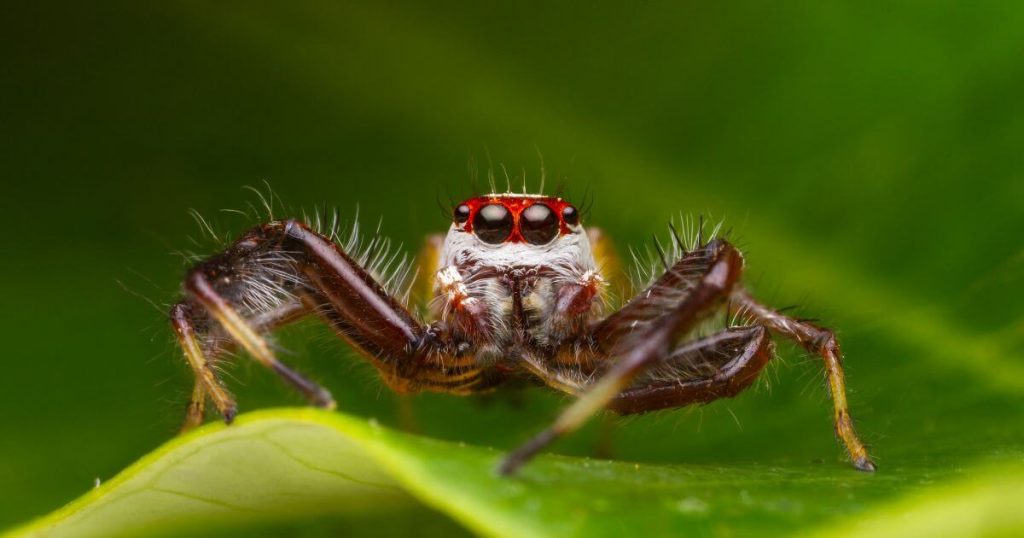
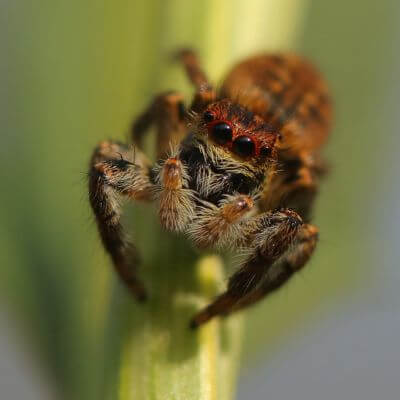
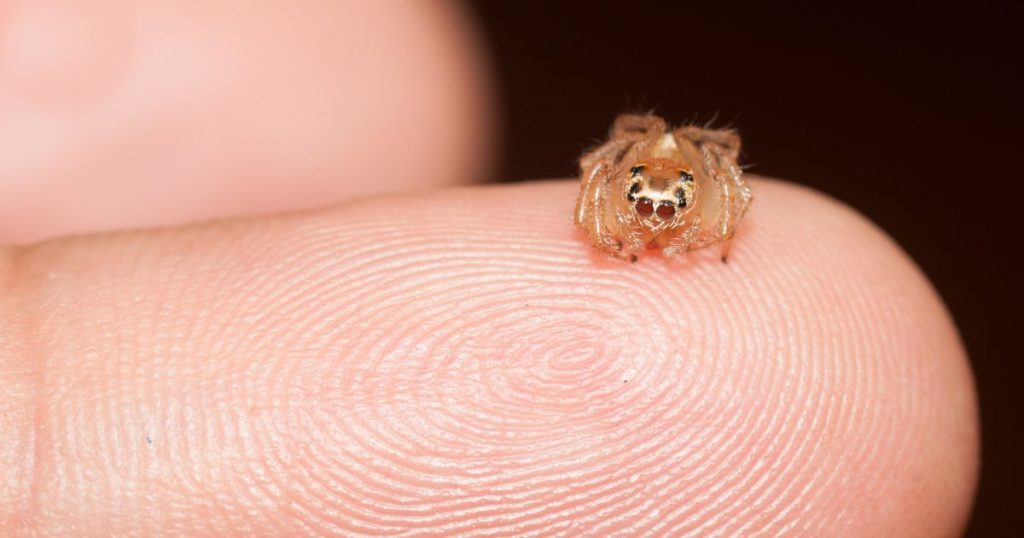
Jumping Spider FAQ
Beginner Guide to Raising Quail at Home
What are the Signs of a Dog Concussion?
What Causes Your Dog’s Ears to Smell Bad?
When your dog’s ears start to emit an unpleasant odor, it might leave you puzzled…
Methimazole Treatment for Cat Hyperthyroidism
Methimazole plays a crucial role in managing feline hyperthyroidism, a condition marked by an overactive…
Got Hummingbirds in your Backyard? Here’s How to Care for Them.
Why Does Your Cat Pee Outside the Litter Box?
Cat’s Litter Box Issues It’s not uncommon for cat owners to face the frustrating dilemma…




